Inbound marketing is more than a digital marketing buzzword. A new survey of 501 businesses that use inbound marketing shows that, when implemented correctly, inbound marketing is a highly effective marketing strategy that increases businesses’ leads and conversions. Inbound marketing can also help businesses track and improve their marketing efforts for better results because it focuses on tailoring content to individual users’ needs.
Marketing automation company HubSpot pioneered the inbound marketing approach in 2005. Now, 79% of North American businesses use inbound marketing to engage customers with their products and services, according to HubSpot’s annual State of Inbound Report.
Inbound marketing helps businesses succeed by attracting and nurturing leads to the point of conversion. Outbound marketing, by contrast, relies on promotion that interrupts audiences with traditional advertisements, phone calls, or other sales tactics.
For example, a catering business following the inbound marketing methodology might choose to release a series of how-to videos about cooking for large groups that it shares on its social media channels to promote its brand rather than invest in television ads.
Inbound marketing can better attract customers because it enhances users' experiences with useful content instead of interrupting them with irrelevant promotional material.
This article helps business decision makers understand current inbound marketing trends and learn how to implement their own strategies.
Our Findings
- Most businesses that use inbound marketing say their leads (72%) and conversions (55%) increased in the past six months, demonstrating the success of inbound marketing campaigns.
- Almost one-quarter (24%) of businesses say attracting leads is the main priority for their inbound marketing strategy, and 24% say converting those leads into customers is their main priority, making inbound marketing an effective strategy for businesses to attract and retain customers.
- Most businesses that use inbound marketing (90%) use social media because social media platforms have huge audiences and are easy to use. Not all businesses, however, use social media effectively.
- Businesses that use inbound marketing are divided on the success of social media campaigns. More than one-third (42%) say social media is the most successful inbound marketing activity, but 21% say it’s the least successful.
- Companies use website traffic (77%), social shares (57%), and email opens and clicks (56%) to track the success of inbound marketing efforts. Website traffic and other metrics inform businesses about their audience’s behavior, which helps businesses create more targeted content and attract increasingly relevant leads.
Businesses Use Inbound Marketing to Increase Leads and Conversions
Inbound marketing drives lead generation and conversion for businesses.
Leads are people or entities who have the potential to become a customer or a subscriber.
A conversion occurs when a website visitor becomes a lead by performing a desired action such as subscribing to a newsletter or downloading a piece of content.
Most businesses using inbound marketing have seen both leads (72%) and conversions (55%) increase in the last six months as a result of their efforts.
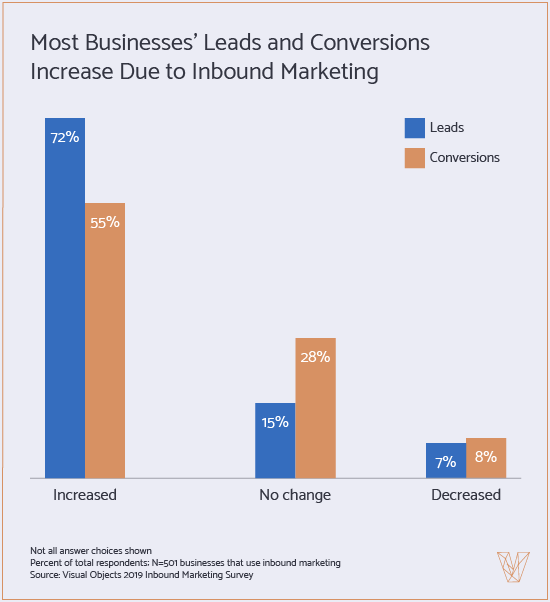
More than one-quarter of businesses (28%) reported no change in their conversions, while 15% did not experience any change in leads.
Only 8% of businesses reported that their conversions had decreased since they began using inbound marketing, while just 7% experienced a decrease in leads.
Inbound marketing is a long-term effort that allows businesses to get to know their customers personally through targeted content and digital tools that track the content’s performance.
Inbound marketing gives businesses the chance to get to know audiences more personally, as users interact with professional brands on social media and on company websites. Studying these interactions helps brands improve their own products and services accordingly, creating a cycle of continuous improvements that increases customer retention.
To begin the cycle, inbound marketers must first direct their leads through a process known as the sales funnel.
The Sales Funnel Drives Inbound Marketing
Inbound marketing is a long-term investment for businesses and relies on a marketing concept called the sales funnel. According to digital marketing website CrazyEgg, the sales funnel represents the path users take to becoming customers.
The graphic below shows the 4 stages of the funnel – awareness, interest, decision, and action.
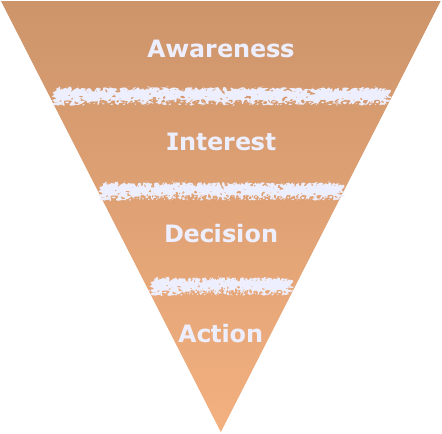
Inbound marketing activities such as content creation and promotion on social media target individuals at the top of the funnel, in the awareness stage.
In the awareness stage, the individual might not be looking to make a specific purchasing decision. It’s still possible, however, for businesses to attract this individual to their offerings by creating content the individual may find useful or interesting.
In successful sales funnels, this content and promotion eventually drives individuals down the funnel to the point of action, when a sale is made or contact information is exchanged.
A web design company, for example, could create an explainer video about how to use a certain brand of web design software such as Squarespace. The company’s marketing team will then post the video on Instagram knowing that many users might find the video useful, even if they are not all currently looking for web design companies.
Some users, however, might see the video and want to learn more about the company that created it. Once interested, these users click a link in the video and navigate to the web design company’s website or landing page.
At the decision stage, users looking for web design services are usually considering a few options. This is a marketers’ opportunity to introduce special deals or offers to stand out from the competition and drive conversions.
The pool of leads grows smaller at every stage of the funnel, leaving the business with leads who are familiar with the brand and ready to act by the end – the action stage.
Inbound marketing attracts top-of-funnel leads with high-quality, useful content. Personalization guides leads down the funnel and drives them to convert.
Businesses Prioritize Attracting Leads When Using Inbound Marketing
Leads are the primary focus for many businesses that practice inbound marketing. Some businesses prioritize attracting leads to their website or content, while others prioritize converting those leads to customers.
Attracting and converting leads are top priorities for almost one-quarter of businesses using inbound marketing (24%).
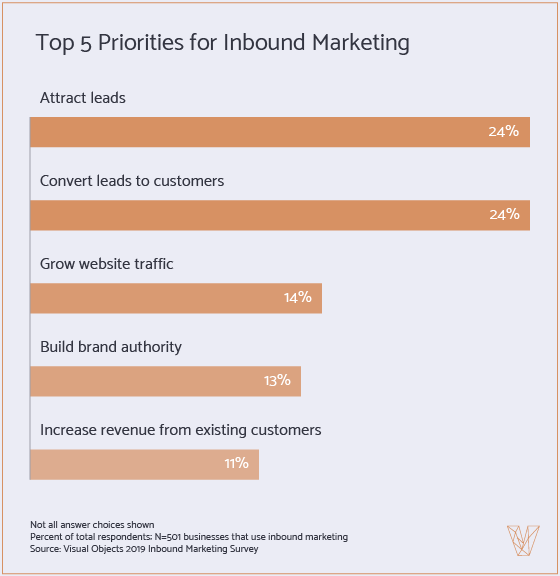
Companies’ inbound marketing priorities also include growing website traffic (14%), building brand authority (13%), and increasing revenue from existing customers (11%).
Björgvin Benediktsson, owner of Audio Issues, a website that creates content for people with home sound studios, prioritizes attracting leads to his website by offering high-quality content that users must submit contact information to access.
Benediktsson uses a lead magnet in his company’s Instagram profile to track the portion of his leads that visit his website from Instagram. A lead magnet is an incentive that businesses offer to potential customers in exchange for their email address or other personal information.
Benediktsson includes his lead magnet in the biography section of his Instagram account, shown below. The lead magnet helps collect users’ emails for future communication.
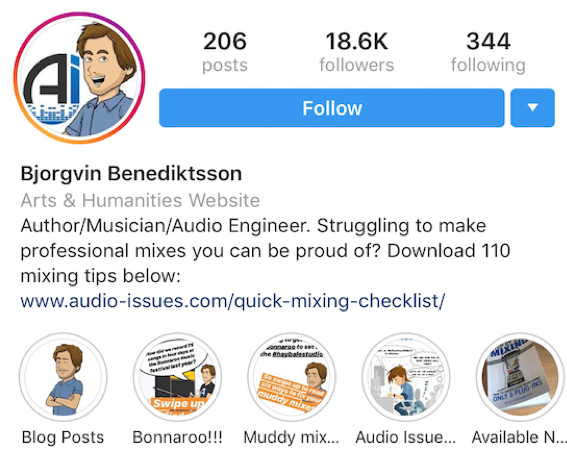
Benediktsson entices users by offering free content. The link in his biography offers "110 mixing tips" to users browsing his Instagram profile.
Users click the link and proceed to the landing page shown below, which offers them a checklist of 110 sound mixing tips.

Source: Audio Issues
The landing page includes an orange call-to-action (CTA) button that says “Get the Checklist!” When users click the CTA, the website prompts them to enter their email in exchange for the checklist.
Benediktsson can track how many leads come to his website from his Instagram account with this lead capture system. The lead capture also collects email addresses, which can then be added to company newsletters or used for targeted promotional emails.
Businesses looking to attract leads should focus on creating quality content and supplementing that content with lead magnets to guide top-of-funnel leads down the sales funnel.
Most Businesses Use Social Media in Their Inbound Strategies
Social media is a natural channel for inbound marketers looking to reach top-of-funnel users. Social media channels are simple and cost-effective outlets for businesses to share their content.
Almost all businesses (90%) incorporate social media into their inbound marketing strategy.
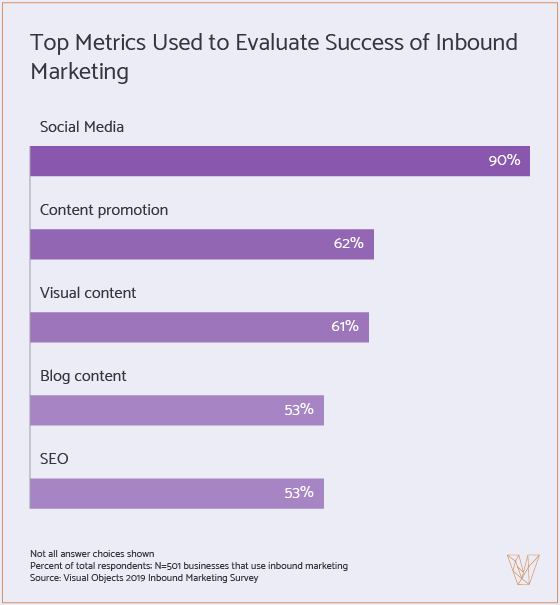
Almost two-thirds of businesses (62%) use content promotion materials, and 61% create visual content to attract audiences. More than half of companies surveyed (53%) incorporate blog content and search engine optimization into their inbound strategies.
Businesses use social media to easily and cheaply promote their offerings. Businesses can also promote other types of content, such as visuals and blog posts, on social media.
Ben Kirst, vice president of creative at Silverback Strategies, a digital marketing agency in Alexandria, Va., believes that social media is popular for businesses using inbound marketing because of the potential to reach a wide audience.
“Everyone is on social because the audiences are there, and they’re such great advertising tools,” Kirst said. “It’s relatively inexpensive to reach a lot of people.”
Social media accounts are often free for businesses to open and operate, with paid options for targeted advertising. Tracking social media metrics such as likes, shares, and other forms of engagement tell businesses which types of content are performing well, informing what types of posts they should create next.
Benediktsson’s inbound marketing strategy entices audiences with free, valuable, and visual content on Instagram, shown below.
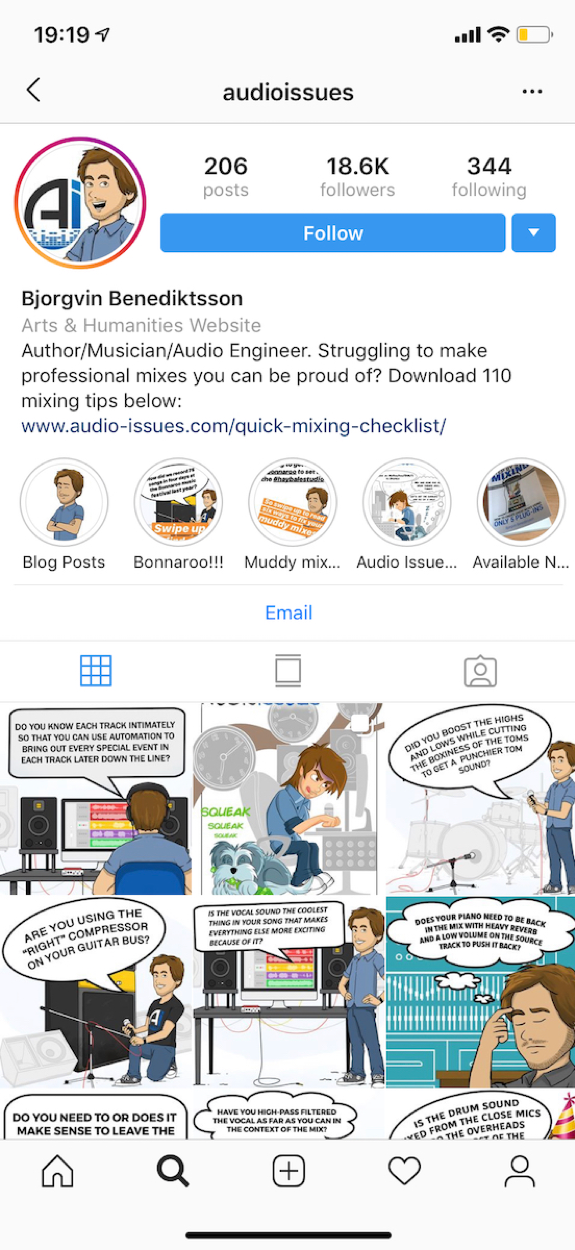
Source: Instagram
Rather than posting pictures of audio equipment, Audio Issues’ Instagram brand involves short comics that explain certain aspects of sound mixing.
These informative cartoon images drive casual browsers to the lead magnet link in his channel’s biography.
By presenting technical information about audio equipment in a fun and unexpected way, Benediktsson created a following for his brand and content. His Instagram account grew from 400 to 19,000 followers in the last year, boosting his business.
Social media is an easy way for businesses to share their content with a wider audience, attracting leads to their website.
Businesses' Social Media Success Depends on Expertise and Industry
Social media is a competitive space for many industries. Businesses should consider seeking professional help and experimenting with paid social media posts to maximize their success.
Although most businesses use social media for inbound marketing, they are divided on the success of their social media campaigns. Nearly half of businesses (42%) say social media is their most successful inbound marketing effort, but 21% say it’s the least successful strategy among all their other marketing activities.

Businesses may underestimate the skills required to succeed on social media because it’s so easy to create profiles and post.
“To really run effective campaigns … takes expertise,” Kirst said. “There’s a degree of impatience and unwillingness to really invest the time and resources needed to gain that level of expertise. [Businesses] want results, and [they] want them now.”
The majority of businesses have a social media presence, but most also manage their accounts with in-house employees. In-house teams can be effective but can often lack the expertise necessary to create campaigns that successfully nurture leads through the sales funnel.
Audio Issues, for example, hired an in-house Instagram expert to grow its channel. In a post on Medium, Benediktsson outlined what he believes made the Instagram account successful.
“I think the personalized hashtags, consistent posting, clean aesthetic, and humorous description tone have all contributed to the growth,” Benediktsson wrote. “In all honesty, I think the single biggest factor has simply been that it is a niche page that most audio engineers would be interested in following.”
Audio Issues’ succeeded by following a consistent Instagram strategy that established a unique brand voice. Audio Issues also benefits from operating in a niche market on Instagram.
Social media is a cost-effective outlet for businesses to share their content to a wide audience at the top of the sales funnel. To successfully grow a following, however, businesses must invest time and human resources in creating and executing strategies for each platform.
Social Media Is Competitive for Certain Industries
In contrast to Audio Issues, certain industries may experience challenges promoting their original content in a heavily saturated social media environment.
Digital marketing companies, for example, face stiff competition when marketing on social media. Bernard May, CEO of digital marketing company National Positions, said his company has experienced mixed results with organic social media content, depending on the client, the niche, and what other tactics and strategies are involved in the overall campaign.
The company has seen even better results with paid social media posts.
“In social, if you're a brand, you are in a pay-to-play world,” May said. “In our paid ad testing, we have been able to gain some impressive traction and awareness to our site, products, and services.”
National Positions’ efforts are most successful when they combine organic social media posts with paid posts, like the below example from LinkedIn.
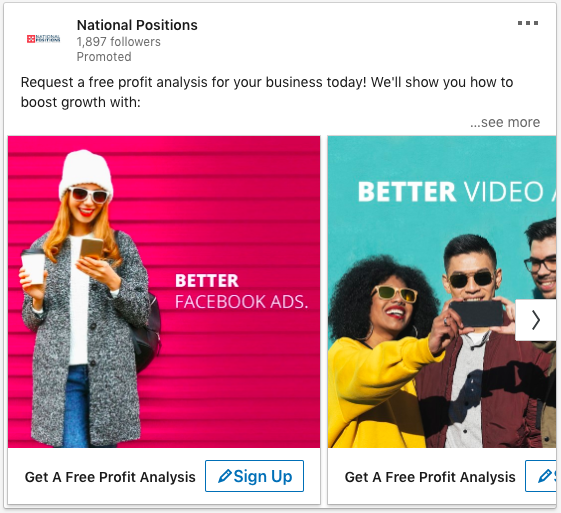
Source: LinkedIn
National Positions’ paid posts incorporate calls-to-action (CTAs) that encourage LinkedIn users to “Sign Up” for its profit analysis offering.
As a digital marketing company, National Positions operates in a competitive space on social media. It combines its social media efforts with other digital strategies to maximize results.
“Our efforts have been most successful when organic social is used in conjunction with our other efforts such as SEO, pay-per-click, and influencer marketing,” May said. “If organic social posting was the only thing we were doing for a client, it would likely not be as effective as it might have been a few years ago.”
In today's social media climate, combining organic social media efforts with paid campaigns can be extremely helpful for businesses in competitive niches.
Businesses using social media for their inbound marketing should work with social media professionals to maximize results. They should also be aware that some industries are more competitive on social media than others and adjust their strategies accordingly.
Businesses Track Metrics to Identify Leads and Personalize Content
Businesses can tailor their content to specific audiences and improve the overall experience for users by examining metrics such as website traffic, social media shares, and website conversions. Website traffic acts as a benchmark for businesses tracking their top-of-funnel marketing content’s success.
Most businesses (77%) track website traffic to measure the success of their inbound campaigns.
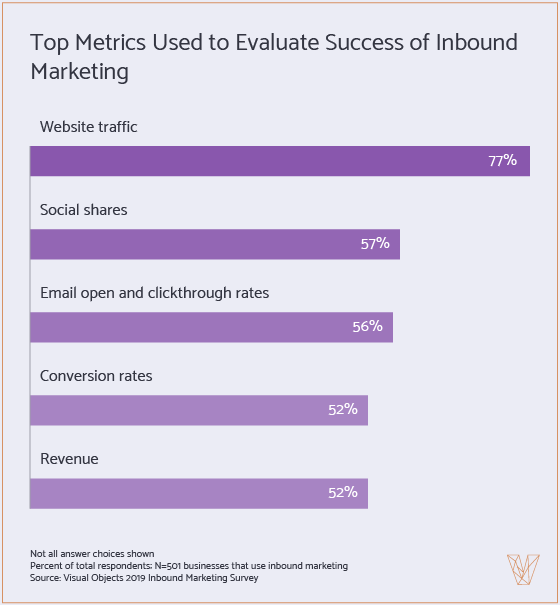
More than half of businesses also track:
- Shares on social media (57%)
- Email open and clickthrough rates (56%)
- Website conversion rates (52%)
- Revenue (52%)
Michael White is the president and co-founder of Atlanta-based digital agency The Creative Momentum. He believes that personalization cultivates real connections in a technology-driven world. Marketing automation systems can help by serving specific content to users based on their previous visits.
“Personalization is huge for adapting to what people are doing,” White said. “With some of the marketing automation tools, you can actually serve specific content to users based on their previous visits.”
White emphasized the importance of using reporting data to build on inbound marketing processes. If a person places a business’s product in his or her cart but does not check out, for example, that person might receive a targeted email from that business with a personalized offer code.
Personalizing content may seem challenging for businesses new to inbound marketing, but businesses can use online tools and resources to streamline a complex process.
Digital Tools Help Businesses Track Inbound Marketing Efforts
Businesses can use digital tools such as tracking pixels and urchin tracking monitor (UTM) codes to evaluate website traffic.
A tracking pixel, or marketing pixel, is a piece of code that tracks user behavior in emails, on landing pages, and on websites.
UTM codes are pieces of text that make each link you create unique to the source of traffic. A business can create different UTM codes for the same blog, for example, to track whether visitors are coming from a newsletter or a social media post.
Google Analytics is one popular tool businesses use to track their website traffic. The Google Analytics dashboard, shown below, shows a business how many unique visitors its website has each month.

Source: Moz
Google Analytics presents data on website visitors in graphs and charts that detail how traffic patterns change over time.
Businesses can also use Google Analytics to understand the sources of their website traffic. UTM codes in social media posts, for example, will populate in Google Analytics and show marketers how much of their daily traffic came from a single post.
Businesses practicing inbound marketing should use tools such as Google Analytics to evaluate the success of their marketing efforts and adjust their strategies accordingly.
Inbound Marketing Strategies Drive Success for Businesses
Inbound marketing focuses on attracting and delighting audiences with useful content. Most businesses that use inbound marketing have seen leads and conversions increase as a result of their efforts.
Businesses that use inbound marketing prioritize attracting and converting leads.
Social media is the most popular activity for inbound marketing because the platforms are easy to use and cost effective.
Businesses are split on social media’s success, however, because of industry competition and a lack of expertise that leads to poor results.
Most inbound marketing activities are easy to track and measure. Website traffic is the top way that businesses measure the success of their inbound marketing efforts.
Inbound marketing is a versatile marketing framework that has demonstrated results for businesses.
About the Survey
Visual Objects surveyed 501 businesses in the U.S. that use inbound marketing as part of their overall marketing strategy.
Almost one-third of businesses surveyed (29%) have 500 or more employees, 20% have between 101 and 500 employees, 27% have 11-100 employees, and 24% have 10 or fewer employees.
Most respondents (71%) are managers or more senior employees; 28% are entry-level or associates.
Almost one-third of businesses (30%) are from the South region, 25% are from the Northeast, 23% are from the Midwest, and 18% are from the West.
Nearly half of respondents (48%) are millennials, 44% are Generation X, and 9% are Baby Boomers.
Almost three-quarters of respondents (74%) are female, and 26% are male.